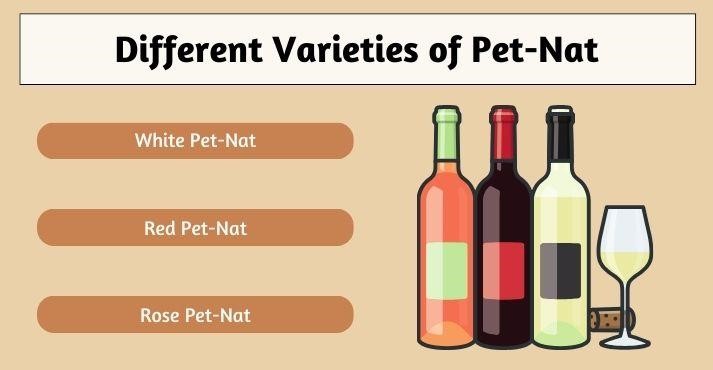Have you heard of bubbly wine gaining popularity for its natural flavors and rustic charm? Meet Petillant Naturel, better known as Pet-nat—an ancient sparkling wine with a modern revival.
While most sparkling wines follow strict production rules, pet-nat wine stands out for its natural fermentation process, resulting in a rustic, lively, and slightly unpredictable drinking experience.
The history of pet-nat dates back to 16th-century France, specifically in the region of Limoux. Known for its ancestral method, this sparkling wine is created through a natural fermentation process that predates the more refined methods used to make Champagne.
Today, pet-nat sparkling wine is experiencing a renaissance, especially among fans of natural wines who appreciate its raw, unfiltered appeal.
What is Pet-Nat Wine?

Pet-nat or Petillant Naturel is a sparkling wine made using the methode ancestrale, an ancient method of producing sparkling wine.
Unlike traditional sparkling wines, which undergo a second fermentation in the bottle with added sugar and yeast, pet-nat is bottled before the first fermentation is complete. This traps the remaining carbon dioxide in the bottle, creating natural bubbles.
Pet-nat is often celebrated for its spontaneous and raw nature. The wine is typically unfiltered, resulting in a cloudy appearance and varying levels of effervescence. They also have a low alcohol content, making them healthy alcoholic beverages for health-conscious consumers.
Because the wine is bottled with active yeast, pet-nat wines can sometimes have sediment, adding to their unpolished charm.
With its roots in France, Petillant Naturel is now produced worldwide, as winemakers welcome the more natural, hands-off approach that defines this sparkling wine.
How is Pet-Nat Made?
The production process of pet-nat wine is unique. It follows the ancestral method, which dates back hundreds of years. This technique creates sparkling wine with minimal intervention, allowing natural fermentation to take its course.
1. Bottling Before Secondary Fermentation
One key step that sets pet-nat apart from other sparkling wines is that it is bottled before the secondary fermentation is complete.
Typically, sparkling wines like Champagne undergo two separate fermentations, but in the case of pet-nat, the wine is bottled before the first fermentation finishes. The remaining sugars in the wine continue to ferment inside the bottle, producing natural carbonation.
This process creates the fizzy bubbles that define pet-nat sparkling wine, but it also leaves the winemaker with less control over the final result, which is part of pet-nat’s charm.
2. Natural Carbonation
Because the fermentation finishes in the bottle, the carbon dioxide produced is trapped, creating natural bubbles.
Unlike Champagne, which gets its carbonation through a secondary fermentation with added sugar and yeast, pet-nat’s bubbles are entirely natural, which results in a gentler effervescence.
This softer fizz and more rustic production method distinguish Petillant Naturel wines from other sparkling wines.
3. The Cloudy Appearance
One characteristic of pet-nat wine is its often cloudy or hazy appearance. Since it is typically unfiltered, sediment, including the active yeast, remains in the bottle. This creates a slightly cloudy look, which adds to the wine’s natural and rustic appeal.
The suspended yeast can also give pet-nat a unique texture and depth, making it a different drinking experience than Champagne’s crystal-clear sparkle.
Flavor Profile of Pet-Nat

One reason pet-nat wine has gained popularity is its unpredictable yet exciting flavor profile. The spontaneous fermentation process and various grape varieties create a wide array of flavors that set pet-nat apart from other sparkling wines.
1. Fruity Aromas
A hallmark of pet-nat sparkling wine is its fresh, fruity aromas. Since pet-nat is made with minimal intervention, the natural fruit flavors of the grapes are front and center.
Depending on the grape variety, Pet-nat can offer citrus, berries, or stone fruit aromas. The fresh fruitiness adds a lively character to the wine.
- Citrus notes: Many white Petillant Naturel wines feature bright lemon or lime flavors.
- Berry flavors: Red or rose pet-nat wines often offer strawberry, raspberry, or cranberry notes.
2. Low Levels of Sugar
Unlike some sparkling wines, which can be pretty sweet, pet-nat is typically low in sugar, offering a drier or off-dry finish.
Since pet-nat is bottled before the primary fermentation is complete, less residual sugar remains in the wine, resulting in a more crisp and refreshing taste.
- Dry to off-dry: Pet-nat’s minimal sugar content makes it an excellent choice for those who prefer less sweetness in their sparkling wines.
3. Unique Character
The most distinctive aspect of pet-nat is its unpredictability. Because the wine is unfiltered and naturally carbonated, every bottle can have slight flavor, texture, and effervescence variations.
This uniqueness is part of what makes pet-nat wine so appealing to wine enthusiasts. Each bottle is a one-of-a-kind experience, offering something new with every pour.
Types of Pet-Nat

Like traditional wines, pet-nat can be made from various grape types, resulting in diverse styles. Here are the most common types of pet-nat sparkling wine based on the grape varieties used:
1. White Pet-Nat
White pet-nat is made from white grape varieties such as Chenin Blanc, Sauvignon Blanc, or Chardonnay. These wines are often bright and zesty, with citrus and green apple flavors. They are light and crisp, making them refreshing for summer sipping.
- Chenin Blanc Pet-Nat: Known for its high acidity and refreshing citrus notes.
- Chardonnay Pet-Nat: Offers a more rounded flavor with hints of apple and pear.
2. Red Pet-Nat
Red pet-nat is less common but equally delightful. It is made from red grapes like Pinot Noir or Gamay.
These wines have more depth and structure than white pet-nat, often featuring berry flavors with a subtle earthiness. Red pet-nat is perfect for those who prefer sparkling wine with a bit more complexity.
- Pinot Noir Pet-Nat: Offers flavors of red berries with earthy undertones.
- Gamay Pet-Nat: Known for its bright cherry and cranberry notes.
3. Rose Pet-Nat
Rose pet-nat strikes a balance between white and red varieties, offering a mix of fresh fruit flavors and a light body. Made from red grape varieties with minimal skin contact, it is often fruity, floral, and slightly tart.
It’s an excellent choice for those who enjoy the freshness of white wine with the depth of red.
- Sangiovese Rose Pet-Nat: Known for its vibrant strawberry and rose petal flavors.
- Grenache Rose Pet-Nat: Offers flavors of watermelon, citrus, and red berries.
Pet-Nat vs. Other Sparkling Wines
While pet-nat sparkling wine shares similarities with other sparkling wines, several key differences set it apart from popular varieties like Champagne, Prosecco, and Cremant.
1. Champagne
Champagne undergoes a more controlled production process compared to pet-nat. It is made using the Méthode Champenoise, which involves a secondary fermentation in the bottle with added sugar and yeast, followed by extensive aging.
In contrast, pet-nat wine is naturally carbonated through its primary fermentation, producing less predictable but more rustic wine.
- Pet-Nat: Bottled before fermentation completes, with natural carbonation.
- Champagne: Undergoes a second fermentation and is aged for longer, with more refined bubbles.
2. Prosecco
Prosecco is typically made using the Charmat method, where the secondary fermentation occurs in a large tank rather than in individual bottles. This method produces lighter, more consistent bubbles than pet-nat.
Prosecco is often sweeter and more fruit-forward than pet-nat, which is usually drier and has a more diverse flavor profile.
- Pet-Nat: Offers a rustic, unfiltered taste with natural carbonation.
- Prosecco: Produced in tanks, resulting in more consistent bubbles and often a sweeter flavor.
3. Cremant
Cremant is a sparkling wine made in France but outside the Champagne region. Like Champagne, it is made using the traditional method, but it tends to be less expensive and lighter in body.
Cremant is generally more refined than Petillant Naturel, celebrated for its raw, unpolished character.
- Pet-Nat: Rustic and unfiltered, with natural fermentation.
- Cremant: Refined and produced using the traditional method, but lighter than Champagne.
Sustainability and Pet-Nat
One of the reasons pet-nat wine has gained so much popularity is its alignment with the natural wine and wine sustainability movements.
Petillant Naturel is often produced using environmentally friendly practices emphasizing low intervention and land respect.
Here’s a look at why pet-nat is considered a sustainable wine and how it fits into the more significant movement toward eco-conscious winemaking.
Why Pet-Nat is Considered a Natural Wine?
Pet-nat is often categorized as a “natural wine” because it is made with minimal intervention.
This means winemakers avoid using added chemicals, commercial yeasts, or filtration methods during production. Instead, the wine is allowed to ferment naturally, relying on the wild yeast present in the grapes.
- Minimal additives: Unlike traditional sparkling wines, pet-nat is usually free from added sugar and preservatives.
- Natural fermentation: The use of native yeasts and the avoidance of chemical interventions make pet-nat a more organic and authentic expression of the grapes.
In many cases, pet-nat sparkling wine is also unfiltered, which allows the yeast and sediment to remain in the bottle. This unpolished approach results in a raw and authentic wine with a cloudy appearance and a slightly rustic flavor profile.
Sustainability Practices in Pet-Nat Production
Many producers of pet-nat prioritize sustainable and environmentally friendly practices, both in the vineyard and the winery.
Biodynamic farming, organic vineyard management, and water conservation are some of the sustainable practices that align with the values of natural winemaking.
- Organic farming: Many pet-nat producers cultivate vineyards without synthetic pesticides or herbicides. This promotes healthier soil and encourages biodiversity in the vineyard ecosystem.
- Biodynamic practices: Some producers take their sustainability efforts even further by following biodynamic farming principles. This holistic approach to farming involves working in harmony with the earth’s natural rhythms, often following the lunar calendar to determine planting and harvesting schedules.
- Low carbon footprint: Pet-nat production typically involves less energy and fewer resources than conventional sparkling wine production. Since pet-nat is made with minimal intervention, there is no need for the additional steps involved in traditional sparkling wine production, such as adding sugar or performing secondary fermentation in a controlled environment.
Food Pairing Suggestions
Pairing Pét-Nat with the right foods can elevate the wine and dining experience. Let’s explore wine-food pairings that complement the unique flavors of Pét-Nat, creating a harmonious fusion for your palate.
1. Light and Fresh Pairings:
- Oysters and Seafood: The crisp acidity of Pét-Nat pairs wonderfully with the saltiness of oysters and the delicate flavors of various seafood dishes. It’s a match that brings out the best in the wine and the ocean’s bounty.
- Caprese Salad: The bright acidity and effervescence of Pét-Nat cut through the richness of fresh mozzarella, tomatoes, and basil in a Caprese salad, creating a refreshing and balanced combination.
2. Creamy and Soft Cheese Pairings:
- Brie and Camembert: The creaminess of Brie and Camembert finds a delightful contrast with the enthusiasm of Pét-Nat. The result is a creamy-meets-bubbly symphony on your palate.
- Goat Cheese: The tanginess of goat cheese complements the lively acidity of Pét-Nat. Try it on a cheese board or as part of a salad for a delightful pairing. Similarly, you can pair it with different cheese types suitable for your taste palette.
3. Spicy and Exotic Pairings:
- Spicy Thai or Indian Cuisine: The enthusiasm of Pét-Nat provides a refreshing counterbalance to the heat in spicy dishes. Whether it’s a curry or a zesty Thai stir-fry, Pét-Nat can handle the spice gracefully.
- Sushi and Wasabi: The clean and crisp profile of Pét-Nat makes it a fantastic companion for sushi. The bubbles help cleanse the palate between bites, while the acidity complements the wasabi and soy sauce flavors.
4. Dessert Pairings:
- Fruit-Based Desserts: Pét-Nat’s fruit-forward nature pairs well with desserts featuring berries, stone fruits, or citrus. Consider a berry tart or a citrus-infused dessert for a delightful finish to your meal.
- Shortbread or Biscuits: The enthusiasm of Pét-Nat contrasts beautifully with the buttery richness of shortbread or biscuits, creating a balanced and satisfying dessert experience.
5. Experimental Pairings:
- Popcorn: The playful nature of Pét-Nat makes it a surprising match for popcorn. The bubbles enhance the textural experience, and the wine’s acidity complements the saltiness.
- Sushi Burritos or Poke Bowls: For a fusion experience, try pairing Pét-Nat with sushi burritos or poke bowls. The combination of fresh ingredients and umami flavors harmonizes with the wine’s lively character.
Conclusion
At its core, when we try to understand what pet-nat is, we understand it’s a naturally sparkling wine made using the methode ancestrale, resulting in a beverage that is both rustic and full of character.
With its unpredictable bubbles, fruity flavors, and cloudy appearance, pet-nat wine stands out in the world of sparkling wines.
When you’re exploring pet-nat sparkling wine for its unique production method, alignment with natural winemaking, or exciting flavors, this ancient wine style is undoubtedly making a modern comeback.
As its popularity continues to rise, especially in Southeast Asia, Petillant Naturel offers an alternative to more conventional sparkling wines like Champagne or Prosecco.
When you’re enjoying a casual glass at a bar or seeking the best bottles in Singapore’s growing wine scene, pet-nat is a wine that promises excitement in every sip.












